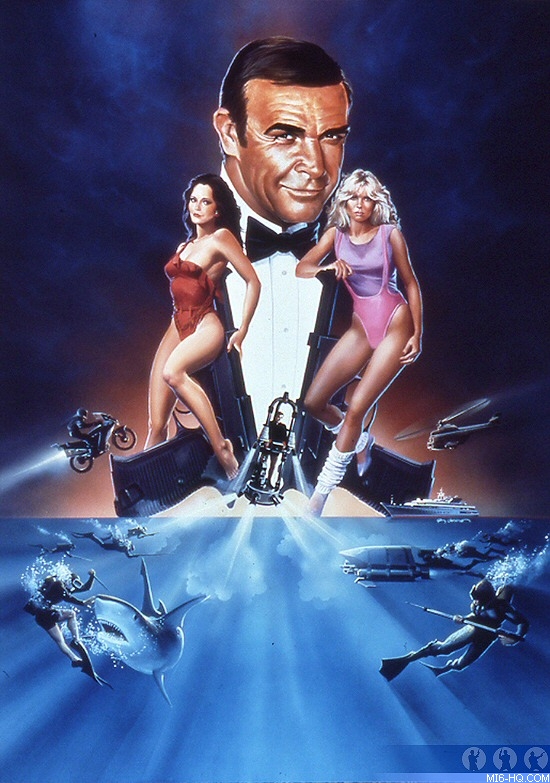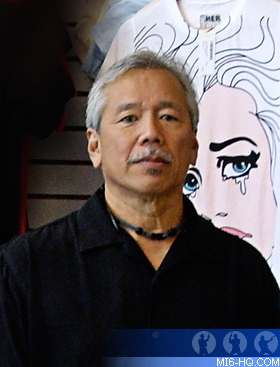 |
| |
MI6 spoke to illustrator Rudy Obrero to discuss his work designing the 'Never Say Never Again' film poster...
|
|
Designing 'Never Say Never Again' - Rudy Obrero Interview
7th August 2010
How did you learn to draw, were you self-taught
or did you take lessons?
I went to a school. I started when I was in the military.
After high school I joined the Air Force and I was a weapons mechanic.
I loaded bombs for B52s. I just happened to stationed on Guam where
there's nothing to do. I was 18 years old with nothing to do.
I
grew up in Hawaii in by the way, so I was used to islands, but
that island was really small. I went to the hobby store. I just
happened to buy a sketchbook instead of a car model. I was going
to go build plastic models of cars but I found a sketchbook instead.
I started sketching from there. I sketched throughout my time in
the military. I wasn't very good but it was something to do. After
that I went to art school. I got better after that!
Who are your greatest inspirations?
All of them... Leyendecker and Howard Pyle. Norman Rockwell. All of
those great guys. They gave a feeling to their art. They didn't just fulfil
a requirement of advertising. They put life into it.
Were you a follower of the Bond movies before being asked to design the poster?
Absolutely. I was a fan when I read all the paperbacks by Ian
Fleming in high school. I was a fan from the first one. Actually, "Goldfinger" was
my favourite. I liked the Oddjobb guy.
Can you tell us how you got involved in the marketing for James Bond in 'Never Say Never Again'?
I worked as a freelancer all my career and I worked through an ad agency called New York West. They were using me for all their work and we had collaborated on a lot of different projects. The James Bond project was a good one!

Above: Rudy's final artwork for "Never Say Never Again"
|
Were you recommended by New York West or were your contacted directly?
The ad agency recommended me. But here's how it worked... The studio
would commission a bunch of ad agencies to do a bunch of different
ideas and comps for each promotion. I was just one artist working
for one agency among many.
Were you given free reign on the project in so far as how you went about the design?
I am limited to the references I get and to the art direction involved.
Each agency gets a direction from the client so that we don't
all repeat. Each agency works and hires a number of different
artists and we get our own directions so that we don't overlap.
It would be useless for three people to be workin on the same
idea.
I had the montage and all the action stuff and
the two ladies and James Bond which is the 'big head'. It's called
a 'big head plus the ladies'. I had action elements in there,
which they all took out. All of those were removed for legal
purposes. The lawyers got involved. Which is really sucky when
you think about it. At time we had lawyers trying to
tell artists what to do.
Did you have the feeling at the time it was somewhat of a 'rogue' James Bond film? Did that in any way affect the way you approached the project?
Although it was based on "Thunderball",
they would cross out any issues that might arouse their legal team. They
kept
pulling the pieces out one at a time. It had to not look like any James
Bond movie at all. If you'll notice there is no flames in there. No fire,
no explosions. We had to keep the fire out which is kind of weird for an action
movie not to have explosions. When you think about it, it looked as if it might
have all been done in ice as there was no big orange flame. But... what are
you going to do?
Above: Watercoloured sketches by Rudy Obrero. More examples of the artist's personal and commercial work is available on his website: www.rudyobrero.com |
At what point were you called in to create the artwork? Had you seen the film or clips from the film?
I was only provided with photo stills. I don't think the film was completed.
I think when we work on the advertising its way before the film is even finished.
Sometimes it's a year in advance. Sometimes even longer. Sometimes the films
don't even come out!
When the artwork is never released do you retain the rights to your art?
No, I don't. I usually work for hire. Most of the things in my career I don't
even care where it ends up. I fulfil a requirement. I have fun painting and
then I move onto the next one. There's nothing out there I truly love.
How did you begin to design the poster and how long does a process like that take from start to finish?
It took about a week. I get thumbnails, two or three thumbnails and I work
in pencil so it looks more accurate as to what it's going to be. Then the
agency chooses, the art director chooses, one of those sketches, or bits
and pieces from them and they assemble one composite layout that they like.
I go ahead and do a full sized 'comprehensive'. It's a painting that is as
tight as a finish but in some small ways it is not a finish. I did three
for the Bond movie.
What was the most challenging/interesting aspect of designing the Bond poster for you?
Having it make sense every time an element would be pulled out. I'd have to
have this big spot that was big and empty. All of a sudden, how did I accommodate
the big and empty space and balance it out again? Because, this layout was
symmetrical. It was balanced on both sides. When you pulled one element out
it looked heavy on one side. It wasn't digital back then, I had to paint
out and redraw and put it back in.
Did you work in acrylic or oil?
The Bond posters are acrylic but earlier in my career I used oils for the rich colours but art directors could not handle storing it. They'd just stack it against other things and it'd stick and I would have to fix up all the art again.
Acrylic dries quick and it's not tacky as an oil painting.
On an oil painting, six months later, it's still sticky, especially if
you lean something against it. Oil was not a good idea for commercial
art. It would have been if everyone knew how to store it, but nobody
did.
Do you recall your work on James Bond opening many doors for your future career and if so what work did you win from the film?
Yeah, it was good thing to have in my portfolio especially because we had it on billboards in LA. It was on some prime spots. Everyone was like, "Oh you're the guy that did that!"
It didn't turn out to be the way I wanted it but its still James Bond and I'm still a fan! |
|

Above: Rudy Obrero.
|
Many thanks to Rudy Obrero.